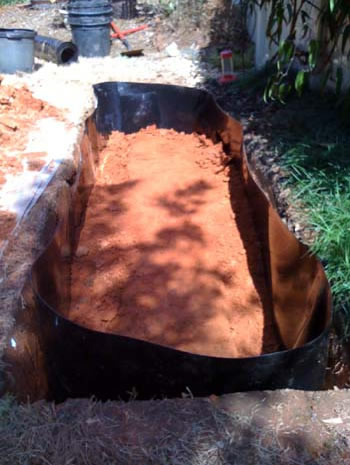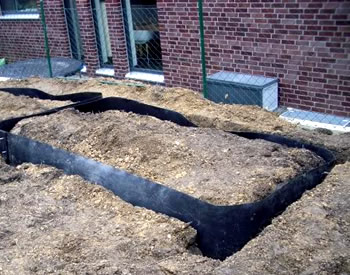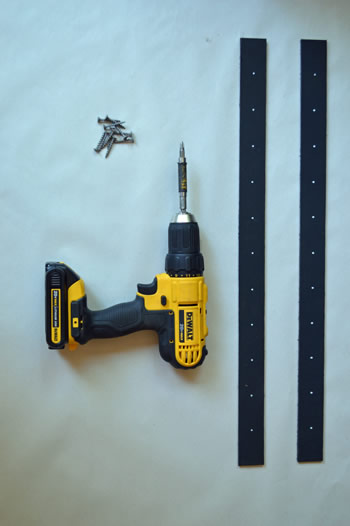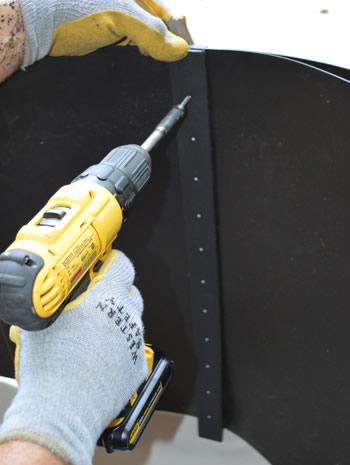How To Install Bamboo Root Barrier
Step-By-Step Instructions for Installing Bamboo Barrier

1 - Using paint marker, field marker or a garden hose to outline the shape of the area in which you want your bamboo to grow. Keep in mind that the larger the mature size of a specific species or variety of bamboo the larger the contained area will need to be for the bamboo to reach its full potential. For larger growing Phyllostachys bamboo you should have a circumference (distance around the planting bed) of at least 30 feet.
2 - Using a trenching shovel or a motorized trenching machine, dig a trench to precisely 22 inches deep for 60 mil liner or 28 inches deep for 80 mil liner around the perimeter of your planting bed. The trench can be anywhere from 8 to 12 inches wide. For narrow planting beds it may be easier just to remove all the soil from the planting bed. When digging, remove the top soil first then the heavier subsoil, stacking these seperately.
3 - Place the barrier in the trench so that it stands 2 inches above ground level. This prohibits the bamboo rhizomes (roots) from growing over the top without being detected and also serves as an edger to contain mulch applied.
4 - Overlap the ends of the barrier by 2 feet or so and then secure using a 30" Stainless Steel Barrier Clamp.
See instructions below for installing the clamp.
5 - Back fill the trench first with the sub-soil, and compact this to drive out all air pockets. Then complete backfilling with the top soil and pack that tight, too. Make sure no sharp objects (stones, glass, metal, or tree roots) come into contact with the barrier. If the backfilled soil is not packed in tight, when the rhizomes contact with the barrier, they may be able to travel down through the loose soil and escape beneath the barrier, undetected.
 6 - The use of bark mulch or other loose, organic substances spread 2 to 5 inches deep over the top of your planting area within the barrier encourages the rhizomes to spread just inches below the surface, making them very easy to locate and prune. Mulch also makes for a healthier bamboo.
6 - The use of bark mulch or other loose, organic substances spread 2 to 5 inches deep over the top of your planting area within the barrier encourages the rhizomes to spread just inches below the surface, making them very easy to locate and prune. Mulch also makes for a healthier bamboo.
See and Buy Bamboo Barrier Liner here
How to Install the Bamboo Barrier Clamp
 Pictured right is our banding straps and screws provided with the kit. Our straps are made out of the same material as the barrier to prevent rusting. The straps are offered in 24" or 30" lengths. Thickness is 1/4" each.
Pictured right is our banding straps and screws provided with the kit. Our straps are made out of the same material as the barrier to prevent rusting. The straps are offered in 24" or 30" lengths. Thickness is 1/4" each.
A screwdriver or cordless drill with a #2 phillips head will be need to secure the fasteners.
1 - First step is to allow adequate overlap of the two barrier ends to be secured. We recommend 2+ feet. Outdoor duct tape (3M and Gorilla Glue both make good products) is beneficial to hold the material together and close seams.
2 - Then you need to align the bamboo barrier clamps (bars) on both sides of the barrier material.
3 - After clamps are aligned, position screw over marked location (white dots) and screw into closest clamp strip, both sides of barrier and clamp strip on the opposite side.
4 - Secure screws all the way down the strap on pre-marked locations.
See and Buy Bamboo Barrier Clamps here

.





